Interpretive Wayfinding
Principal Chris Muskopf, AIA shares how enhanced methods of graphic signage, known as Interpretative Wayfinding, transforms navigation into true engagement within museums, institutions and landscaped environments.
View Post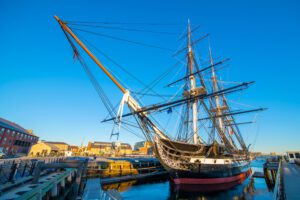
No other form of transportation conjures adventure and bravery, romance and escape, resilience and self-reliance more than a boat. Since Neolithic times, humans have used watercraft as an efficient mode of both transport and domicile, traversing waterways in battle and exploration and for commerce and leisure. The myriad of uses is matched only by the myriad of vessel types, and all have a compelling tale to tell. Working with maritime museums, CambridgeSeven brings mariner stories to life through engaging and innovative exhibit design. We’re sharing a few of our recent seafaring favorites along with how we capture that excitement to enthrall everyone from landlubbers to seadogs.
Mystic Seaport Museum, a living history and maritime museum, has an enviable collection of historic seafaring vessels, including 900 small craft, some of which will be the centerpiece of the Seaport’s newest showcase at Wells Boat Hall. Of the hundreds of boats in the collection, all captured our imagination, but the oldest and newest exemplify the thrill of the sport.
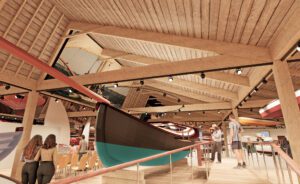
Built in 1898 and the first acquisition in the Seaport’s collection, Annie is a sandbagger sloop, a unique vessel popular in 19th century that was designed as a work boat and valued as a racer. Sandbagger sloops were descendants of the oyster sloops, with wide shallow drafts, which made them ideal for navigating shallow waters. Their sails are oddly scaled to the size of the hull and they require crews of 10 to 15 to handle the large sails and unusual sandbag ballast, from which the boats get their name. This is tricky sailing – to really get a sandbagger moving, the crew has to maneuver the oversized sails while shifting 50lb sandbags to find optimum speed. It made for thrilling and dangerous races and Annie is an original winner.
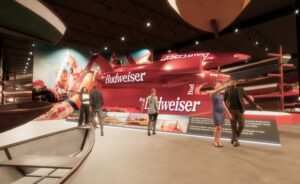
What do you get when you mix an F-16 with a boat and a little alcohol? In the hands of professionals, you get the Budweiser-branded, hydroplane racing series, Miss Budweiser. With sobering speeds clocking over 200 mph, these hydroplanes dominated their racing class. Over their 40-year history, the distinctive red hull and monster engines blurred the line between watercraft and aircraft.

The life aboard a submarine takes a special kind of courage, stamina and trust. Claustrophobic quarters, immersed in a hostile environment and mysterious surroundings for long stretches of time, it’s no surprise that Jules Verne found them rich inspiration for his tales. Today’s sophisticated naval submarines are worlds away from the precarious submersible vessels of years past on which brave souls embarked in the name of innovation and exploration.
One such vessel, the H.L. Hunley, the world’s first attack submarine, will be a featured artifact in the Submarine Science Center (SSC) in Charleston, S.C., a world-class maritime museum where visitors will experience the amazing science and history of submarines. Through highly interactive exhibits, this hands-on science center will inspire visitors to explore and understand the forces that govern our deepest oceans, from navigation, propulsion, buoyancy, and balance, to how we control a submarine and what it is really like to live onboard one of these incredible underwater machines. Indeed, Jules Verne would delight in a visit to the SSC immersing himself in what were once fanciful visions to what has now become a reality.
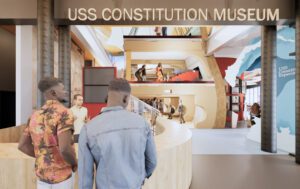
Old Ironsides and her heroic role in the War of 1812 is an often-told story in U.S. History classes. But that’s only 3 years out of her 227-year history. The U.S. Navy’s longest commissioned warship, the USS Constitution is a floating icon of American history with many stories to share. She is berthed at the Charlestown Navy Yard and is regularly taken out to keep her hull and crew shipshape. Half a million people visit each year and will soon be able to enjoy the expanded USS Constitution Museum being built near her dockage. Our exhibit team is designing interactive and informative experiences to animate this long and varied history, highlighting her tales of adventure and accomplishment.
Seeking to expand influence and commerce amid a changing global power shift, the USS Constitution’s role in the Navy morphed from battleship to ambassadorship. The years following the War of 1812 marked a period of extraordinary U.S. expansion and the Constitution was deployed to cruise the world’s ports, acting as diplomat, protector, and witness to history.
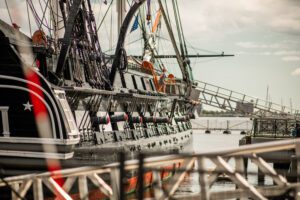
The ambitious World Cruise spanned 2 years, 24 ports of call, and 52,000 miles, crossing from South America to Africa, Southeast Asia and back. Her mission was to establish trade relations with new countries and to protect existing merchant routes and interests. The Constitution’s show of strength was personified by her captain, John ‘Mad Jack’ Percival, who may not have exercised the most diplomatic approach in the contentious yet delicate business of reconfiguring trade relationships but had the necessary fortitude to get his 450-men crew through the arduous adventure. U.S. influence as a global superpower had begun.
During the World Cruise, the Constitution’s crew likely took part in one of Maritime’s oldest traditions, Crossing the Line – a rite of passage when crossing the equator. Tradition dictates that homage is due to King Neptune in appreciation of his acceptance. Sailors dress the part of King Neptune and his court of mermaids in a play to initiate the Pollywogs, or inexperienced sailors, on their maiden voyage. In the past, this initiation could veer to brutal hazing but in today’s U.S. Navy, the voluntary celebration works in the spirit of ship comradery to boost morale among all Neptune’s Shellbacks.
Want to learn more? We encourage a visit to these fascinating museums in person or online to discover your inner mariner.
Principal Chris Muskopf, AIA shares how enhanced methods of graphic signage, known as Interpretative Wayfinding, transforms navigation into true engagement within museums, institutions and landscaped environments.
View PostModern sports museums and exhibits are moving beyond the game to highlight academic subjects such as physics, women's studies and history within their experiences.
View Post